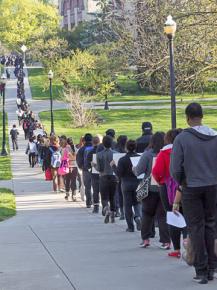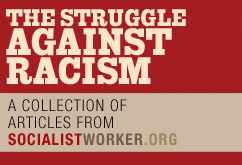Taking on hate at Ohio State
reports on days of antiracist organizing on campus in Columbus.
THE CAMPUS of Ohio State University (OSU) in Columbus erupted with anti-racist actions following two hate crimes that occurred after a "hoodies and headscarves" rally to mourn the racially motivated murders of Trayvon Martin and Shaima Alawadi.
On the evening of Wednesday, April 3, around 200 students, staff and community members gathered on campus for a remembrance for Trayvon and Shaima, donning headscarves and hoodies in their honor and showing solidarity with similar actions that have taken place throughout the country. The event followed a rally for Trayvon the previous weekend at the state Capitol in downtown Columbus, which drew around 1,500 people.
Though the campus event was mostly peaceful and solemn in tone, it was briefly interrupted when a white man charged through the crowd, wearing an empty gun holster around his waist. The same man had posted racist comments, including words of support for Trayvon's murderer, George Zimmerman, on the Facebook event page for the rally.
Campus police pulled the man from the crowd and removed him from campus, though no arrest was made in what was just the first of several escalating acts of intimidation.

The next morning, the campus community awoke to the news that the exterior of the Frank Hale Jr. Black Cultural Center had been defaced with the words "Long Live Zimmerman."
Throughout the day, hundreds of students attended meetings hosted by various groups, including the campus NAACP, Occupy Ohio State and the Black Student Association (BSA), in order to coordinate a response to an obvious attempt to intimidate Black students and everyone who had come together the night before to oppose racist violence.
The largest of the meetings drew around 200 people, most of them students, to the Black Cultural Center that evening. Attendees expressed outrage not only at the hate speech, but at the university's lack of response and the general culture on campus. The audience at the BSA-led meeting developed a three-point list of demands to bring to a meeting of the university Board of Trustees, which was meeting the next morning.
First, the group demanded that the university send out a "Hate Crime Alert" e-mail to the entire student body announcing the defacement of the Black Cultural Center.
Attendees pointed out that the university sends "Crime Alerts" any time someone in the area surrounding campus is mugged or assaulted, often with an irresponsibly vague description of the assailant as a "black male wearing a hoodie."
Ohio State professor Terrell Strayhorn explained that as a young-looking Black man, such alerts are incredibly disruptive and make him avoid going onto campus the day such an alert is released. OSU student James Hayes reminded the crowd that with these crime alerts, the university contributes to the very culture in which Trayvon Martin was followed and killed for being a young Black man in a hoodie.
Though the university regularly sends out alarming reports of criminal activity, it hadn't done so in the case of the vandalism to the Black Cultural Center. An act of hate intended to intimidate African Americans and opponents of racism, speakers argued, was just as threatening to campus safety, if not more so.
Second, the group demanded that the administration enact policies to make the university population, including both the student body and the faculty, more accurately reflect the racial makeup of the nation as a whole.
University President Gordon Gee has repeatedly claimed in recent years that Ohio State sets the tone for the culture and values of the rest of the country. But currently, only around 3 percent of faculty are African American, and the percentage of students who are Black on the main OSU campus has decreased over the past decade.
Thirdly, the group demanded "inclusion, and not just tolerance," at the university. Here, organizers wanted to address ongoing, long-term changes to the campus culture, and for further concrete changes in the coming weeks.
THE NEXT morning, on April 5, a racially diverse crowd of around 200 people dressed in all black, many of them wearing black hoodies to make the connection to the murder of Trayvon Martin, met at 8 a.m. and marched in a single-file line across campus to the Longaberger Alumni House where the Board of Trustees meeting was in progress.
Gee and the trustees had been informed of the group's intentions by administrators who attended the meeting the night before. When marchers arrived, the Trustees invited them into the meeting and gave them speaking rights. Board members insisted they were on the activists' side, shared their outrage and were eager to hear their recommendations.
After two student representatives read a prepared statement listing each of the three demands, Gee informed the demonstrators that he had formed a task force on the incident, which would announce actions three weeks from then.
After leaving the meeting, protesters learned that a second racist graffiti had been discovered--a mural of Barack Obama giving a speech, located just east of campus on the edge of a mostly Black neighborhood, was defaced with two spray-painted swastikas and an anti-Black slur.
The news of the second hate crime and the foot-dragging students had received from the Trustees created a new sense of urgency. The protesters had previously agreed to hold a sit-in at the OSU student union building later that afternoon to bring awareness of the crime to the rest of the student body. They quickly decided the sit-in should begin at Noon.
At Noon, protesters marched into the Union, a very prominent and busy building on campus, carrying signs they had carried that morning, and chanting, "O-H-I-O, Racism has got to go!" a chant which plays on the "O-H-I-O" cheer popular at OSU sporting events.
The sit-in grew as people around campus heard about it, and it quickly attracted media attention. News of the action spread on Twitter through the hashtag #OSUstandyourground, which referenced the Florida Stand Your Ground law that has allowed George Zimmerman to avoid arrest.
While in the Union, students brought out a "hoodies and headscarves" banner that people who had attended the Wednesday night rally had signed with anti-racist messages. Those at the sit-in were encouraged to sign the banner if they hadn't already. Around 4 p.m., protesters unfurled the banner from the ornate second-floor railings of the Union, and the crowd erupted in applause.
Early in the sit-in, protesters held a meeting to decide on next steps and agreed to continue occupying the Union until the university met its first demand--that a "Hate Crime Alert" be sent to the student body.
Administrators--who had been present at the sit-in and had helped arrange food and drinks as well as a sound system for the protesters--relayed the demands to the administration. The administration, which had been eager to avoid the appearance that the protesters were taking on the university, acted quickly. At around 5 p.m., the e-mail alert arrived in student inboxes.
Around 5:30 p.m., protesters ended the sit-in by exiting the Union in another single-file march to the Black Cultural Center. They continued to meet until late in the evening, discussing next steps for accomplishing their other two demands.
THE PROTESTS of the last week have been some of the largest and most urgent instances of organizing against racism at the university in decades.
They come on the heels of a series of large and militant actions on campus since the Occupy movement began last fall, including demonstrations against the university's anti-labor practices and potential contract with Dallas Cowboys Merchandising, an apparel corporation known to use sweatshop labor. Other focuses for protests include rising tuition costs and student debt, and the university's involvement in the destruction of Poindexter Village, some of the city's oldest public housing, located in a neighborhood the university has participated in gentrifying without involvement from residents.
The anti-racist actions included student organizations that have not previously coalesced, including the NAACP, BSA, Muslim Student Association, Latino Student Association, College Democrats and the groups that worked together around campaigns in the Occupy movement, including United Students Against Sweatshops and the Columbus branch of the International Socialist Organization.
This coming together of different organizations to take a strong stance against racism has been powerful and inspiring to all those involved, especially since we were able to win one immediate and important concession from the administration in around 36 hours. Further questions, including the relationship of Black and white participants in a movement against racism, and how students should relate to the university power structure, have emerged for discussion in the coming weeks.
It's clear that hundreds of OSU students not previously involved in activism have become radicalized in the last week--and are ready to stand their ground and say "Enough is enough!"



